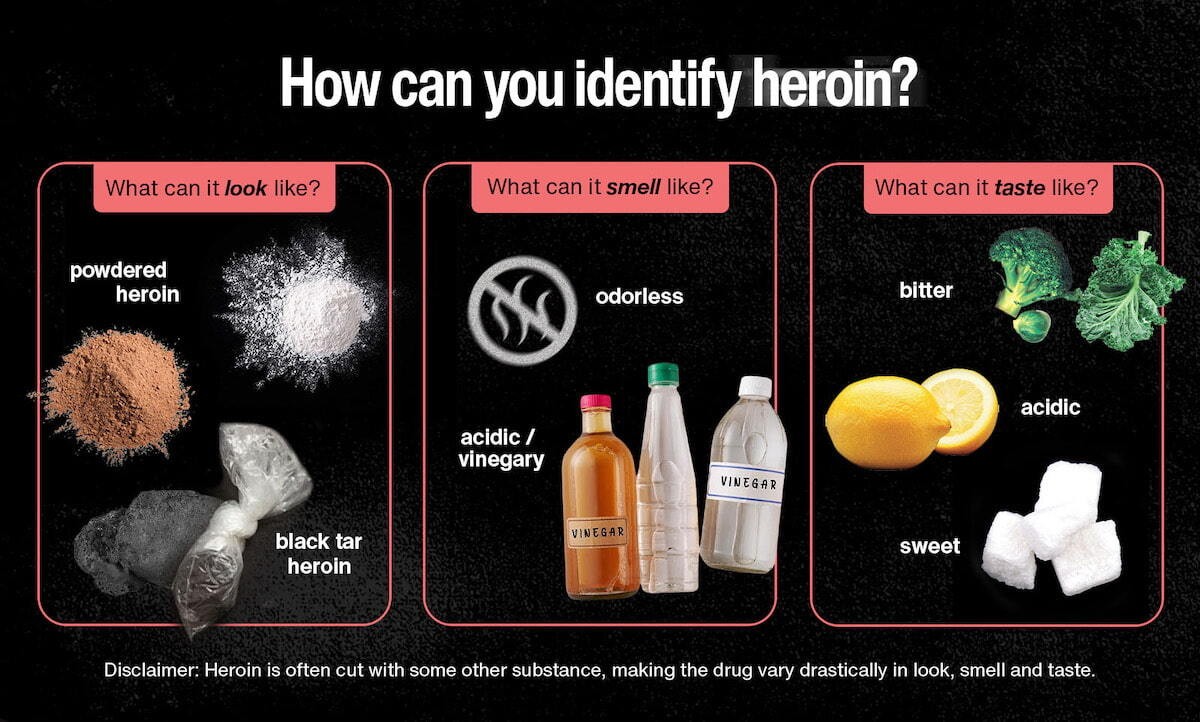Heroin is a highly addictive opioid substance that poses a significant threat to public health. In 2020, over 10,000 overdose deaths in the US involved heroin, highlighting the critical need for awareness and prevention. Many more fatalities are attributed to fentanyl unknowingly consumed as heroin. Recognizing heroin in its various forms and understanding associated paraphernalia is crucial for preventing accidental exposure and responding effectively in emergency situations. This guide will detail what heroin looks like and other key identifiers.
Types of Heroin: Powdered and Black Tar
Heroin primarily exists in two main forms, differing significantly in appearance and texture: powdered heroin and black tar heroin. Despite these visual differences, both forms are used via similar methods of consumption.
Powdered Heroin
Powdered heroin is the more commonly encountered form, typically appearing as a light brown, beige, tan, gray, or even white powder. Its fine texture, similar to flour, can sometimes lead to misidentification with other powdered substances. Users administer powdered heroin through various methods:
- Smoking: Often done using glass pipes or aluminum foil. The “chasing the dragon” method involves placing heroin on aluminum foil, heating it from below, and inhaling the resulting smoke with a straw.
- Snorting: Powdered heroin can be directly inhaled into the nasal passages, often with the aid of a straw or rolled-up currency to facilitate administration.
- Injecting: Injection is a prevalent method due to its rapid onset of effects, with heroin entering the bloodstream almost immediately. Paraphernalia associated with heroin injection includes:
- Hypodermic needles: For injecting the dissolved heroin.
- Spoons or bottle caps: Used to dissolve heroin in water, often heated.
- Tie-offs: Strings, shoelaces, or rubber tubing used to make veins more prominent for injection.
- Cotton balls: Used as filters when drawing the heroin solution into the needle.
- Lighters or candles: To heat the heroin and water mixture for dissolution.
Black Tar Heroin
Black tar heroin is a less refined, cruder form of the drug. Its appearance is markedly different from powdered heroin, presenting as a dark brown to black, sticky, tar-like substance. This dark coloration and sticky consistency result from impurities left over from the production process. Like powdered heroin, black tar heroin is primarily used by:
- Smoking: Using similar methods as powdered heroin, such as foil and a lighter.
- Injecting: Also injected using needles and similar paraphernalia. However, the sticky nature of black tar heroin increases the risk of skin infections and abscesses at injection sites.
A visual guide highlighting key sensory indicators for heroin identification: appearance, smell, and taste.
Identifying Heroin: Appearance, Smell, and Taste
When trying to identify heroin, understanding its various sensory characteristics is key.
What Heroin Looks Like: Color and Texture
The question ” what does heroin look like?” is best answered by understanding its two primary forms.
- Powdered Heroin Appearance: Typically ranges from white to light brown, beige, or gray. Its texture is fine and powdery, resembling flour. This similarity to other white powders makes visual identification alone challenging.
- Black Tar Heroin Appearance: Distinctly dark in color, ranging from dark brown to black. It has a sticky, tar-like consistency, sometimes appearing shiny or like a clump of dark resin.
Heroin Smell: Vinegar-like Odor
Smell can be another indicator, although not always definitive:
- Powdered Heroin Smell: Pure powdered heroin is often odorless. However, street-level heroin is frequently cut with additives, which can impart an acidic, vinegar-like smell. The presence and strength of this smell can vary.
- Black Tar Heroin Smell: Generally has a more pronounced vinegar odor due to its less refined nature and higher impurity levels. However, the absence of a strong smell does not rule out the presence of heroin.
Heroin Taste: Bitter Flavor
Taste is not a safe method for identification and is strongly discouraged due to the dangers of heroin. However, for informational purposes:
- Heroin Taste: Heroin is described as having a bitter taste. Additives used to cut heroin can alter the flavor, potentially making it acidic, bitter, or even slightly sweet. Again, tasting any unknown substance is dangerous and should be avoided.
The Hidden Dangers: Heroin Adulteration
One of the most significant dangers of heroin use is that it is almost invariably adulterated or “cut” with other substances. These cutting agents, used to increase bulk and profit, can include substances like powdered milk, sugar, starch, or even other drugs.
This practice of cutting heroin means that users rarely know the actual purity or composition of what they are ingesting. The unpredictable nature of street heroin makes it extremely easy to consume a dangerously high dose unintentionally, leading to a heightened risk of accidental overdose. The presence of unexpected substances can also introduce additional health risks.
Seeking Help for Heroin Dependency
Recognizing what heroin looks like is just one aspect of addressing the broader issue of heroin use and its consequences. For individuals struggling with heroin dependency, seeking professional help is crucial. Evidence-based treatments, including medication-assisted treatment (MAT) and behavioral therapies, are effective in supporting recovery. Resources are available to help individuals find treatment options and begin their journey toward recovery and preventing further harm from this dangerous substance.
Advertisement banner for Ophelia’s online medication-assisted treatment program for opioid use disorder.

